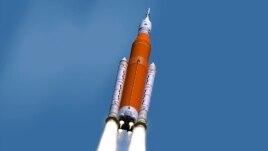16 March, 2019
NASA's large new rocket will not be ready for launch next year, the American space agency's top official said this week.
NASA Administrator Jim Bridenstine told a Senate committee that he is thinking about using rockets made by private companies to keep the planned June 2020 launch date.
NASA's delayed rocket is called the Space Launch System, or SLS.

This illustration made available by NASA shows the Space Launch System during liftoff. On Wednesday, March 13, 2019, NASA's top official said the space agency's new rocket won't be ready for a moon shot next year. (Marshall Space Flight Center/NASA via AP)
It's a "critical piece of what NASA needs to build," Bridenstine told the Senate Commerce, Science and Transportation Committee.
Bridenstine added that NASA would need two private rockets to take over the SLS' job of launching the Orion capsule and an upper stage. Orion must dock with the upper stage in orbit around Earth before going to the Moon.
"This is 2019," Senator Roger Wicker, the committee chairman, told Bridenstine. "I'd sure like to keep us on schedule."
The first test flight had first been planned for this year. "I want to be clear: NASA has a history of not meeting launch dates, and I'm trying to change that," Bridenstine said.
NASA seeks a sustainable moon program. In the past, Apollo lunar landings were direct trips from and back to Earth. The goal now is to have a base with astronauts near the moon.
Orion would not carry a crew and would not land on the moon. Instead, the Orion would get close to the Moon before traveling beyond it.
A NASA statement says Orion "will travel 280,000 miles [450,000 kilometers] from Earth, thousands of miles beyond the Moon over the course of about a three-week mission."
The statement adds, "Orion will stay in space longer than any ship for astronauts has done, without docking to a space station, and return home faster and hotter than ever before."
NASA is already using private companies to make International Space Station shipments. If private rockets were to be used for the 2020 mission, SLS would be put in operation for NASA's second exploration mission by 2023.
I'm John Russell.
Marcia Dunn reported on this story for AP News. John Russell adapted it for Learning English. Caty Weaver was the editor.
________________________________________________________________
Words in This Story
capsule – n. a small part of a spacecraft that is separate from the rest of the spacecraft and that is where people live and work
stage – n. a particular point or period in the growth or development of something
sustainable – adj. able to last or continue for a long time
schedule – n. a plan of things that will be done and the times when they will be done
dock – v. to join together (two spacecraft) while in space
We want to hear from you. Write to us in the Comments Section.